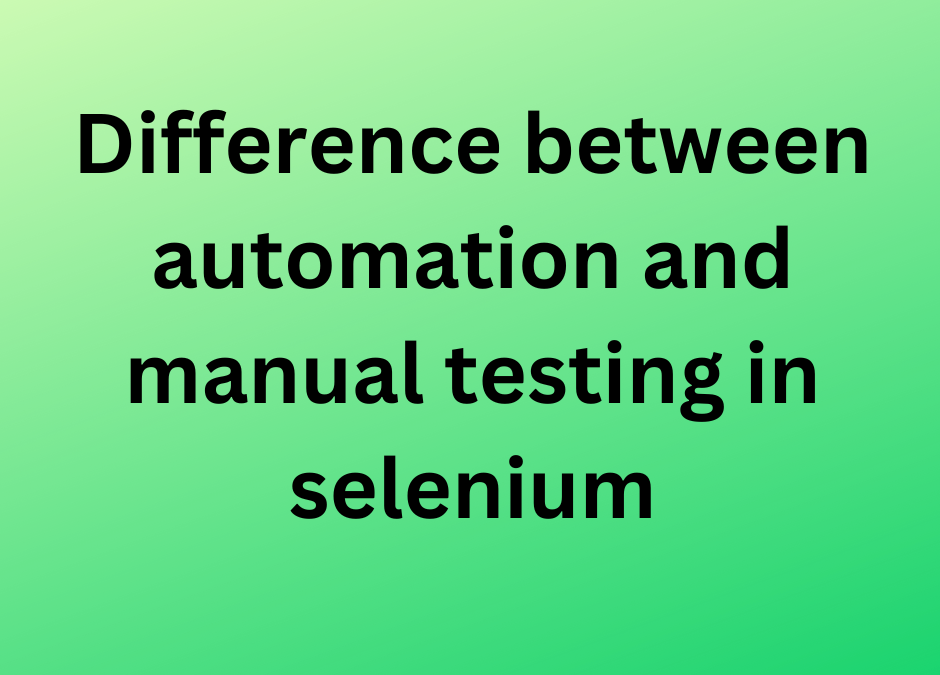Selenium is a popular software testing tool used for automating web browsers. It can be used for both manual and automated testing. Here are 11 differences between Selenium automation testing and Selenium manual testing:
we are providining Selenium training in coimbatore Selenium is a popular web automation tool that is used to test web applications. It helps to detect errors and automate repetitive tasks.
- Human Intervention: The most obvious difference between manual and automation testing is human intervention. Manual testing involves a human tester who performs tests manually, while automation testing is performed using scripts and automation tools.
- Speed: Automation testing is generally faster than manual testing because scripts can be executed much faster than a human tester can perform the same tasks.
- Cost: Automation testing can be more expensive upfront due to the cost of the automation tools and the time required to write the scripts. However, it can be more cost-effective in the long run because it requires fewer testers and can be run more frequently.
- Accuracy: Automation testing is generally more accurate than manual testing because scripts are written to perform the same tasks consistently.
- Reliability: Automation testing is more reliable than manual testing because it is not affected by human factors such as fatigue or inconsistency.
- Repetitive tasks: Automation testing is ideal for repetitive tasks that need to be performed frequently, such as regression testing.
- Ad-hoc testing: Manual testing is better suited for ad-hoc testing, where the tester is exploring the application and looking for issues that may not have been discovered through scripted tests.
- Learning curve: Automation testing requires a higher level of technical expertise than manual testing, which can make it more difficult to learn.
- Debugging: Debugging can be more challenging in automation testing because it requires a good understanding of the script code.
- Maintenance: Maintenance can be more challenging in automation testing because scripts need to be updated every time there is a change in the application being tested.
- Flexibility: Manual testing is more flexible than automation testing because it allows testers to adapt to changes in the application being tested quickly. Automation testing requires scripts to be updated every time there is a change in the application being tested.
- Reusability: Automation testing scripts can be reused multiple times, which can save time and effort in the long run. On the other hand, manual testing requires every test case to be executed manually, which can be time-consuming.
- Test Coverage: Automation testing can achieve a higher test coverage as it can perform the same tests repeatedly without errors, and in a shorter time than manual testing.
- Test Results: Automation testing generates test results automatically which makes it easier to analyze and compare them, while manual testing generates test results manually which can be less accurate.
- Test Environments: Automation testing requires a stable and consistent test environment, while manual testing can be performed in any environment.
- Test Data: Automation testing requires test data to be pre-configured and integrated with the testing framework, while manual testing can use ad-hoc data.
- Non-Functional Testing: Automation testing can be used to test non-functional requirements such as performance, security, and scalability. Manual testing may not be sufficient for testing non-functional requirements.
In summary, the choice between Selenium automation testing and Selenium manual testing depends on the project requirements, budget, and time constraints. While automation testing is faster, more reliable, and scalable, it requires a higher level of technical expertise and may not be suitable for ad-hoc testing or testing non-functional requirements. On the other hand, manual testing is more flexible, adaptable, and can be useful for ad-hoc testing and exploring the application.
Scalability: Automation testing is more scalable than manual testing because it can be easily expanded to cover more test cases or to test multiple configurations and environments simultaneously.

